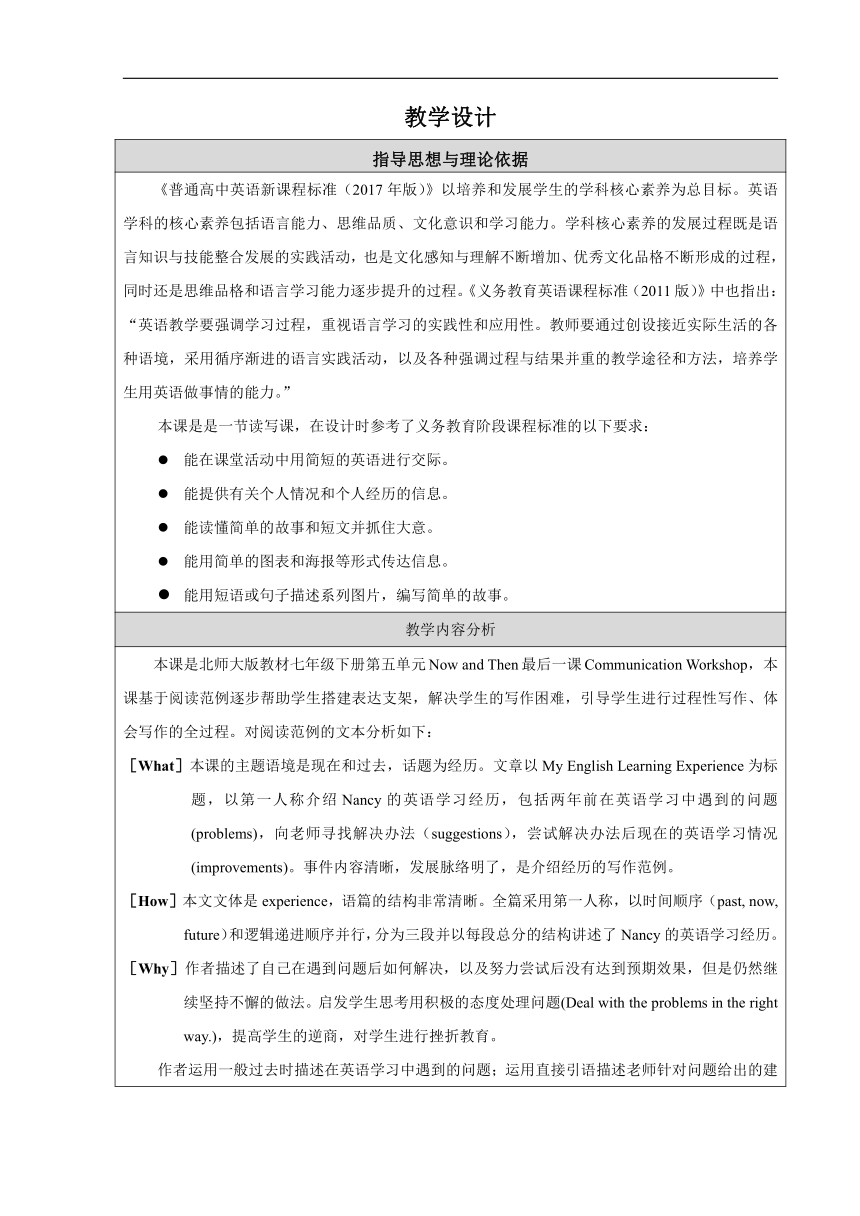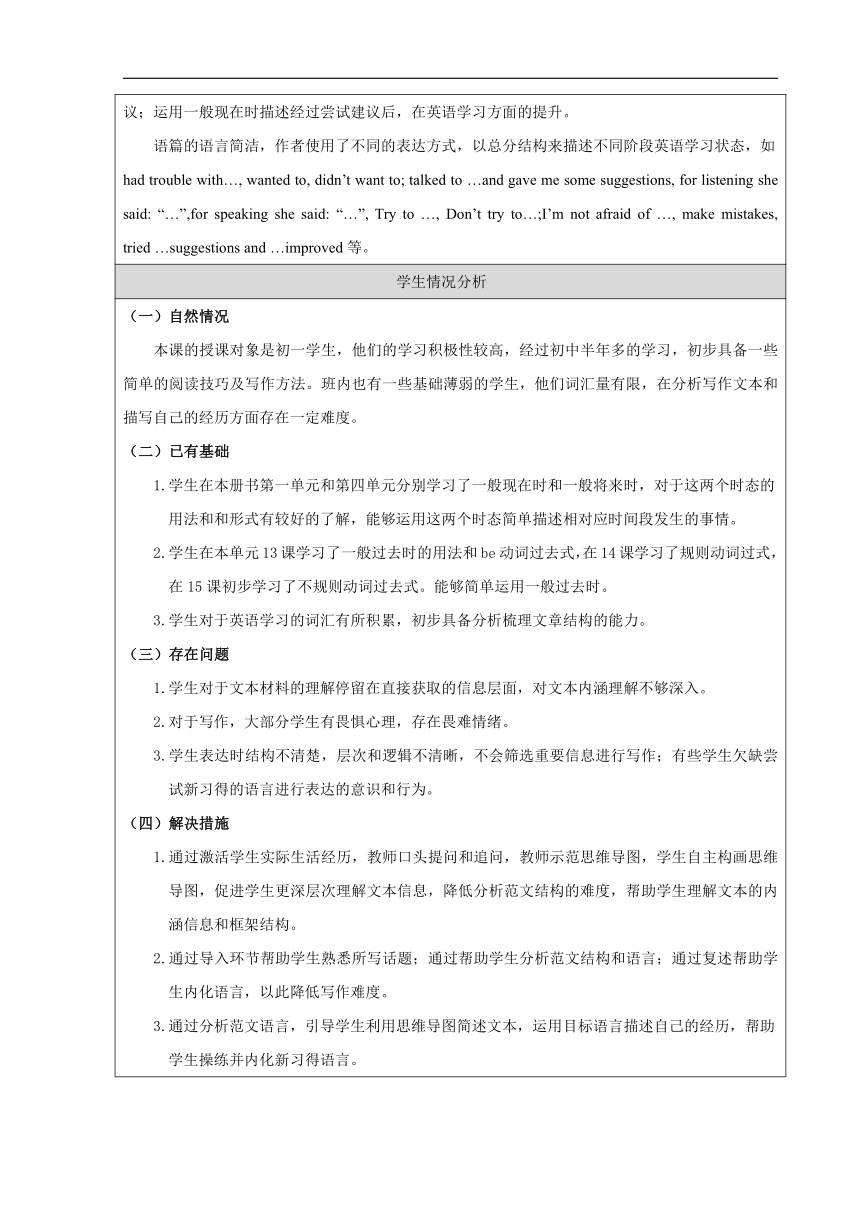Unit 5 Now and Then Communication Workshop 教学设计(表格式)
文档属性
| 名称 | Unit 5 Now and Then Communication Workshop 教学设计(表格式) |

|
|
| 格式 | doc | ||
| 文件大小 | 63.5KB | ||
| 资源类型 | 教案 | ||
| 版本资源 | 北师大版 | ||
| 科目 | 英语 | ||
| 更新时间 | 2022-06-13 14:03:08 | ||
图片预览


文档简介
教学设计
指导思想与理论依据
《普通高中英语新课程标准(2017年版)》以培养和发展学生的学科核心素养为总目标。英语学科的核心素养包括语言能力、思维品质、文化意识和学习能力。学科核心素养的发展过程既是语言知识与技能整合发展的实践活动,也是文化感知与理解不断增加、优秀文化品格不断形成的过程,同时还是思维品格和语言学习能力逐步提升的过程。《义务教育英语课程标准(2011版)》中也指出:“英语教学要强调学习过程,重视语言学习的实践性和应用性。教师要通过创设接近实际生活的各种语境,采用循序渐进的语言实践活动,以及各种强调过程与结果并重的教学途径和方法,培养学生用英语做事情的能力。”本课是是一节读写课,在设计时参考了义务教育阶段课程标准的以下要求:能在课堂活动中用简短的英语进行交际。能提供有关个人情况和个人经历的信息。能读懂简单的故事和短文并抓住大意。能用简单的图表和海报等形式传达信息。能用短语或句子描述系列图片,编写简单的故事。
教学内容分析
本课是北师大版教材七年级下册第五单元Now and Then最后一课Communication Workshop, 本课基于阅读范例逐步帮助学生搭建表达支架,解决学生的写作困难,引导学生进行过程性写作、体会写作的全过程。对阅读范例的文本分析如下:[What]本课的主题语境是现在和过去,话题为经历。文章以My English Learning Experience为标题,以第一人称介绍Nancy的英语学习经历,包括两年前在英语学习中遇到的问题(problems),向老师寻找解决办法(suggestions),尝试解决办法后现在的英语学习情况(improvements)。事件内容清晰,发展脉络明了,是介绍经历的写作范例。[How]本文文体是experience,语篇的结构非常清晰。全篇采用第一人称,以时间顺序(past, now, future)和逻辑递进顺序并行,分为三段并以每段总分的结构讲述了Nancy的英语学习经历。[Why]作者描述了自己在遇到问题后如何解决,以及努力尝试后没有达到预期效果,但是仍然继续坚持不懈的做法。启发学生思考用积极的态度处理问题(Deal with the problems in the right way.),提高学生的逆商,对学生进行挫折教育。作者运用一般过去时描述在英语学习中遇到的问题;运用直接引语描述老师针对问题给出的建议;运用一般现在时描述经过尝试建议后,在英语学习方面的提升。语篇的语言简洁,作者使用了不同的表达方式,以总分结构来描述不同阶段英语学习状态,如had trouble with…, wanted to, didn’t want to; talked to …and gave me some suggestions, for listening she said: “…”,for speaking she said: “…”, Try to …, Don’t try to…;I’m not afraid of …, make mistakes, tried …suggestions and …improved等。
学生情况分析
(一)自然情况 本课的授课对象是初一学生,他们的学习积极性较高,经过初中半年多的学习,初步具备一些简单的阅读技巧及写作方法。班内也有一些基础薄弱的学生,他们词汇量有限,在分析写作文本和描写自己的经历方面存在一定难度。(二)已有基础1.学生在本册书第一单元和第四单元分别学习了一般现在时和一般将来时,对于这两个时态的用法和和形式有较好的了解,能够运用这两个时态简单描述相对应时间段发生的事情。2.学生在本单元13课学习了一般过去时的用法和be动词过去式,在14课学习了规则动词过式,在15课初步学习了不规则动词过去式。能够简单运用一般过去时。3.学生对于英语学习的词汇有所积累,初步具备分析梳理文章结构的能力。(三)存在问题1.学生对于文本材料的理解停留在直接获取的信息层面,对文本内涵理解不够深入。2.对于写作,大部分学生有畏惧心理,存在畏难情绪。3.学生表达时结构不清楚,层次和逻辑不清晰,不会筛选重要信息进行写作;有些学生欠缺尝试新习得的语言进行表达的意识和行为。(四)解决措施1.通过激活学生实际生活经历,教师口头提问和追问,教师示范思维导图,学生自主构画思维导图,促进学生更深层次理解文本信息,降低分析范文结构的难度,帮助学生理解文本的内涵信息和框架结构。2.通过导入环节帮助学生熟悉所写话题;通过帮助学生分析范文结构和语言;通过复述帮助学生内化语言,以此降低写作难度。3.通过分析范文语言,引导学生利用思维导图简述文本,运用目标语言描述自己的经历,帮助学生操练并内化新习得语言。
教学目标
At the end of the lesson, the students will be able to: 1. decide what contents need to be included in their English learning experience; 2. work out an outline of their English learning experience based on the structural analysis of the sample text; 3. identify the useful sentence patterns and expressions from the sample text and use them to describe their English learning experience orally; 4. learn to deal with problem in the right way in their life.
教学重点和难点
Main learning focus: What and how to write my English learning experience.Potential difficulties: May have barriers to decide what contents need to be included in their English learning experience and analyze the structure of the sample text.
教学流程
教学阶段 教师活动 学生活动 设置意图 技术应用 时间安排
Step1What to write. Lead-in1. Show the title and let students know what they should write today. 1. Listen to the teacher and think. 通过本课标题导入,让学生明确本课目标,初步感知写作内容。 PPT and blackboard. 10minutes
2. Ask students the following questions about their English learning experience. Lead the students pay attention to past, now and future. 2. Answer the questions and think. 用提问形式,引导学生思考what to write,初步明确写作内容,为写作做铺垫。
Step 2How to write. 1. Ask the students to read the sample text and answer the questions.1.) How many parts are there in the passage 2.) What does the writer mainly write in each part 2. Check the answers. Further questions:1) When she had problems, what did she do 2) After she got suggestions, what did she do next 1. Read and answer the questions. Discuss the answers in groups. 2. Check the answers together. 引导学生获取每段主要内容, 梳理每段之间的关系,初步提取文章框架。 PPT and blackboardBlackboard. 20minutes
3. Ask the students to read the first part and underline the key information.4. Check the answers. 3. Read the first part and underline the key information. Think about how the writer writes the problems. 4. Check the answers in class. 引导学生阅读获取关键信息。通过追问,帮助学生梳理第一部分文本信息,提取第一部分写作框架。
5. Ask the students to read the second and third part. Finish the mind map with the key information. 5. Draw the mind map. Think about how the writer writes suggestions and improvements. 通过构建第二、三部分思维导图,学生提取第二、三部分写作框架。
6. Show an example. Ask the students to find out the sentence pattern and expressions. 6. Highlight the sentence pattern and expressions. 提取写作目标语言,为写作做准备。
Step 3Practicing and Writing. 1.Ask the students to retell one part of the sample text together by using the mind map and expressions they’ve learned. 1. Retell one part of the sample text by using the mind map and expressions they’ve learned. 借住思维导图,帮助学生内化目标语言,深入理解范文框架结构,实现第一步语言输出。 Blackboard 14minutes
2. Ask the students to retell the sample text individually by using the mind map and expressions they’ve learned. 2. Try to retell the sample text by using the mind map and expressions they’ve learned. 进一步内化目标语言,更加深入理解范文框架结构。
3.Ask the students to draw their own mind maps based on the structural analysis of the sample text and their own English learning experience. 3. Try to draw their own mind maps based on the structural analysis of the sample text and their own English learning experience. 构建作文的思维导图,搭建写作框架和主要内容。
4. Ask the students to talk about their mind map using the expressions they’ve learned. 4. Try to talk about their mind map using the expressions they’ve learned. 学生利用思维导图简单口述作文,运用所学语言做事情,实现第二步语言输出。
Step 4Why to write. 1. Lead the students think about why to write. 1. Try to answer and think. 启发学生思考用积极的态度处理生活中的问题。 (Deal with the problems in the right way.) PPT and blackboard. 1 minute
Step 5 Summary and homework. 1. Summarize and assign the homework. 1. Take down notes and finish homework after class. 通过口、笔头表达方式巩固本课所学。
指导思想与理论依据
《普通高中英语新课程标准(2017年版)》以培养和发展学生的学科核心素养为总目标。英语学科的核心素养包括语言能力、思维品质、文化意识和学习能力。学科核心素养的发展过程既是语言知识与技能整合发展的实践活动,也是文化感知与理解不断增加、优秀文化品格不断形成的过程,同时还是思维品格和语言学习能力逐步提升的过程。《义务教育英语课程标准(2011版)》中也指出:“英语教学要强调学习过程,重视语言学习的实践性和应用性。教师要通过创设接近实际生活的各种语境,采用循序渐进的语言实践活动,以及各种强调过程与结果并重的教学途径和方法,培养学生用英语做事情的能力。”本课是是一节读写课,在设计时参考了义务教育阶段课程标准的以下要求:能在课堂活动中用简短的英语进行交际。能提供有关个人情况和个人经历的信息。能读懂简单的故事和短文并抓住大意。能用简单的图表和海报等形式传达信息。能用短语或句子描述系列图片,编写简单的故事。
教学内容分析
本课是北师大版教材七年级下册第五单元Now and Then最后一课Communication Workshop, 本课基于阅读范例逐步帮助学生搭建表达支架,解决学生的写作困难,引导学生进行过程性写作、体会写作的全过程。对阅读范例的文本分析如下:[What]本课的主题语境是现在和过去,话题为经历。文章以My English Learning Experience为标题,以第一人称介绍Nancy的英语学习经历,包括两年前在英语学习中遇到的问题(problems),向老师寻找解决办法(suggestions),尝试解决办法后现在的英语学习情况(improvements)。事件内容清晰,发展脉络明了,是介绍经历的写作范例。[How]本文文体是experience,语篇的结构非常清晰。全篇采用第一人称,以时间顺序(past, now, future)和逻辑递进顺序并行,分为三段并以每段总分的结构讲述了Nancy的英语学习经历。[Why]作者描述了自己在遇到问题后如何解决,以及努力尝试后没有达到预期效果,但是仍然继续坚持不懈的做法。启发学生思考用积极的态度处理问题(Deal with the problems in the right way.),提高学生的逆商,对学生进行挫折教育。作者运用一般过去时描述在英语学习中遇到的问题;运用直接引语描述老师针对问题给出的建议;运用一般现在时描述经过尝试建议后,在英语学习方面的提升。语篇的语言简洁,作者使用了不同的表达方式,以总分结构来描述不同阶段英语学习状态,如had trouble with…, wanted to, didn’t want to; talked to …and gave me some suggestions, for listening she said: “…”,for speaking she said: “…”, Try to …, Don’t try to…;I’m not afraid of …, make mistakes, tried …suggestions and …improved等。
学生情况分析
(一)自然情况 本课的授课对象是初一学生,他们的学习积极性较高,经过初中半年多的学习,初步具备一些简单的阅读技巧及写作方法。班内也有一些基础薄弱的学生,他们词汇量有限,在分析写作文本和描写自己的经历方面存在一定难度。(二)已有基础1.学生在本册书第一单元和第四单元分别学习了一般现在时和一般将来时,对于这两个时态的用法和和形式有较好的了解,能够运用这两个时态简单描述相对应时间段发生的事情。2.学生在本单元13课学习了一般过去时的用法和be动词过去式,在14课学习了规则动词过式,在15课初步学习了不规则动词过去式。能够简单运用一般过去时。3.学生对于英语学习的词汇有所积累,初步具备分析梳理文章结构的能力。(三)存在问题1.学生对于文本材料的理解停留在直接获取的信息层面,对文本内涵理解不够深入。2.对于写作,大部分学生有畏惧心理,存在畏难情绪。3.学生表达时结构不清楚,层次和逻辑不清晰,不会筛选重要信息进行写作;有些学生欠缺尝试新习得的语言进行表达的意识和行为。(四)解决措施1.通过激活学生实际生活经历,教师口头提问和追问,教师示范思维导图,学生自主构画思维导图,促进学生更深层次理解文本信息,降低分析范文结构的难度,帮助学生理解文本的内涵信息和框架结构。2.通过导入环节帮助学生熟悉所写话题;通过帮助学生分析范文结构和语言;通过复述帮助学生内化语言,以此降低写作难度。3.通过分析范文语言,引导学生利用思维导图简述文本,运用目标语言描述自己的经历,帮助学生操练并内化新习得语言。
教学目标
At the end of the lesson, the students will be able to: 1. decide what contents need to be included in their English learning experience; 2. work out an outline of their English learning experience based on the structural analysis of the sample text; 3. identify the useful sentence patterns and expressions from the sample text and use them to describe their English learning experience orally; 4. learn to deal with problem in the right way in their life.
教学重点和难点
Main learning focus: What and how to write my English learning experience.Potential difficulties: May have barriers to decide what contents need to be included in their English learning experience and analyze the structure of the sample text.
教学流程
教学阶段 教师活动 学生活动 设置意图 技术应用 时间安排
Step1What to write. Lead-in1. Show the title and let students know what they should write today. 1. Listen to the teacher and think. 通过本课标题导入,让学生明确本课目标,初步感知写作内容。 PPT and blackboard. 10minutes
2. Ask students the following questions about their English learning experience. Lead the students pay attention to past, now and future. 2. Answer the questions and think. 用提问形式,引导学生思考what to write,初步明确写作内容,为写作做铺垫。
Step 2How to write. 1. Ask the students to read the sample text and answer the questions.1.) How many parts are there in the passage 2.) What does the writer mainly write in each part 2. Check the answers. Further questions:1) When she had problems, what did she do 2) After she got suggestions, what did she do next 1. Read and answer the questions. Discuss the answers in groups. 2. Check the answers together. 引导学生获取每段主要内容, 梳理每段之间的关系,初步提取文章框架。 PPT and blackboardBlackboard. 20minutes
3. Ask the students to read the first part and underline the key information.4. Check the answers. 3. Read the first part and underline the key information. Think about how the writer writes the problems. 4. Check the answers in class. 引导学生阅读获取关键信息。通过追问,帮助学生梳理第一部分文本信息,提取第一部分写作框架。
5. Ask the students to read the second and third part. Finish the mind map with the key information. 5. Draw the mind map. Think about how the writer writes suggestions and improvements. 通过构建第二、三部分思维导图,学生提取第二、三部分写作框架。
6. Show an example. Ask the students to find out the sentence pattern and expressions. 6. Highlight the sentence pattern and expressions. 提取写作目标语言,为写作做准备。
Step 3Practicing and Writing. 1.Ask the students to retell one part of the sample text together by using the mind map and expressions they’ve learned. 1. Retell one part of the sample text by using the mind map and expressions they’ve learned. 借住思维导图,帮助学生内化目标语言,深入理解范文框架结构,实现第一步语言输出。 Blackboard 14minutes
2. Ask the students to retell the sample text individually by using the mind map and expressions they’ve learned. 2. Try to retell the sample text by using the mind map and expressions they’ve learned. 进一步内化目标语言,更加深入理解范文框架结构。
3.Ask the students to draw their own mind maps based on the structural analysis of the sample text and their own English learning experience. 3. Try to draw their own mind maps based on the structural analysis of the sample text and their own English learning experience. 构建作文的思维导图,搭建写作框架和主要内容。
4. Ask the students to talk about their mind map using the expressions they’ve learned. 4. Try to talk about their mind map using the expressions they’ve learned. 学生利用思维导图简单口述作文,运用所学语言做事情,实现第二步语言输出。
Step 4Why to write. 1. Lead the students think about why to write. 1. Try to answer and think. 启发学生思考用积极的态度处理生活中的问题。 (Deal with the problems in the right way.) PPT and blackboard. 1 minute
Step 5 Summary and homework. 1. Summarize and assign the homework. 1. Take down notes and finish homework after class. 通过口、笔头表达方式巩固本课所学。
同课章节目录
- Unit 1 Daily Life
- Lesson 1 After School
- Lesson 2 A Dangerous Job
- Lesson 3 Safety First
- Communication Workshop
- Unit 2 On the Weekend
- Lesson 4 Helping at Home
- Lesson 5 Talking to Friends
- Lesson 6 Going Out
- Communication Workshop
- Unit 3 Food and Drink
- Lesson 7 Shopping for Food
- Lesson 8 At a Restaurant
- Lesson 9 Food for Sport
- Communication Workshop
- Unit 4 Seasons and Weathe
- Lesson 10 Weather in Beijing
- Lesson 11 Weather Around the World
- Lesson 12 Summer Holiday
- Communication Workshop
- Unit 5 Now and Then
- Lesson 13 Changes in Our Town
- Lesson 14 My First Day
- Lesson 15 My Favourite Teacher
- Communication Workshop
- Unit 6 The Animal Kingdom
- Lesson 16 My Favourite Animal
- Lesson 17 Interesting Animals
- Lesson 18 An Animal Story
- Communication Workshop
